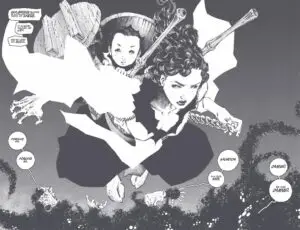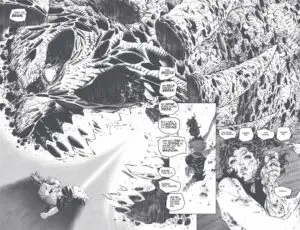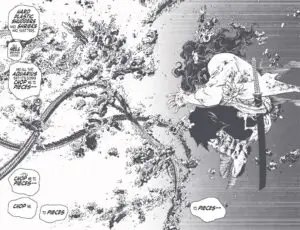Gin and Comic #32: Ronin Rising – Frank Miller’s Return to Cyberpunk Samurai Chaos
On a crisp fall evening, we sat back with a Wormtown Be Hoppy beer—a crisp, well-balanced brew that refreshes without overpowering—and cracked open Ronin Rising. Expectations were high as we returned to Frank Miller’s fusion of cyberpunk dystopia and samurai lore. Miller’s 1983–84 original reshaped the comic landscape, so the bar was set impossibly high. This long-awaited sequel, while not without its stumbles, delivers a visually stunning and ambitious story that doesn’t shy away from risks.

A Legacy Revisited
Frank Miller’s Ronin was a game-changer, blending Eastern and Western storytelling into a kinetic tale of honor, revenge, and existential dread. Now, 40 years later, Ronin Rising picks up the narrative threads in a post-apocalyptic, demon-haunted New York City. Miller teams up with artists Philip Tan and Daniel Henriques, who handle most of the book’s chapters, while Miller himself illustrates chapters 4 and 6. The collaboration brings a new energy to the Ronin saga, though it doesn’t always achieve the cohesion fans might expect.
The story opens with a woman racing through decaying streets, a child strapped to her back as demons close in. Her son, Billy, possesses terrifying telekinetic powers and a connection to the legendary Ronin. Together, they navigate a world of sentient AIs, corporate corruption, and ancient rivalries. While the narrative builds on the foundation of Ronin, it assumes a level of familiarity that might leave newcomers in the dark.

A Visual Feast with Some Uneven Courses
The art is the standout feature of Ronin Rising, showcasing dynamic layouts and breathtaking splash pages. Philip Tan and Daniel Henriques deliver polished, textured illustrations that bring Miller’s chaotic world to life. Battles erupt with ferocity, and the post-apocalyptic setting oozes atmosphere.
When Miller takes over the art in chapters 4 and 6, the tone shifts dramatically. His work is raw, almost primal, lacking the polish of Tan and Henriques but retaining a visceral energy. This change in style may divide readers, but it undeniably adds a layer of unpredictability to the book’s visual narrative. Overall, the art feels like an invitation to linger on each page, soaking in the details and unraveling the chaos.


The Script: Polarizing but Ambitious
Miller’s writing in Ronin Rising swings between moments of intrigue and baffling repetition. Dialogue often feels poetic yet disjointed, leaning heavily on monologues that circle back on themselves. Lines like, “Aquarius erupts. Aquarius screams. The goddamn bitch,” epitomize Miller’s style—bold, unfiltered, and occasionally frustrating.
At its best, the script captures the noir-infused introspection that defined Miller’s early work. At its worst, it teeters on self-indulgence, making the story feel more opaque than it needs to be. Readers unfamiliar with the original Ronin will find little hand-holding here, as the sequel prioritizes advancing its dense mythology over accessibility.
The Spirit of the Original, Reimagined
Despite its uneven pacing and divisive storytelling, Ronin Rising captures the spirit of the original while venturing into new territory. Themes of legacy, honor, and the collision of ancient and modern worlds remain central, but the sequel leans heavily into post-apocalyptic surrealism. This blend of familiarity and reinvention makes Ronin Rising both frustrating and fascinating—a book that demands patience and rewards close attention.
Why Ronin Rising Is Worth the Journey
Ronin Rising isn’t a perfect sequel, but it’s a bold and visually arresting continuation of a groundbreaking story. For fans of Miller’s original work, it’s a chance to revisit a world that helped define modern comics. For new readers, it’s an ambitious, if occasionally disorienting, dive into a genre-blending saga that challenges conventions.
Much like Wormtown’s Be Hoppy, this book is balanced yet complex, offering a refreshing return to form for Miller and his collaborators. Whether you’re drawn in by the art, the legacy, or the sheer audacity of its storytelling, Ronin Rising is a graphic novel that sparks conversation and lingers in the mind.
This review is part of our Amazon Associates program. If you’re interested in Ronin Rising, you can purchase it through this link. Your support helps us continue delivering the best in comic reviews and trade paperback exchanges.
Read this article and more at August Tales Comics. Your go-to site for trade paperback exchanges and comic book news! Trade. Read. Repeat.
#comics #comicbooks #graphicnovel #graphicnovels #augusttales


